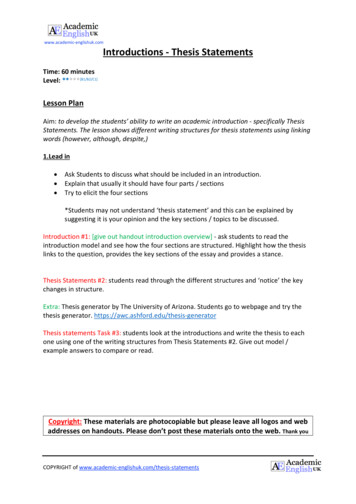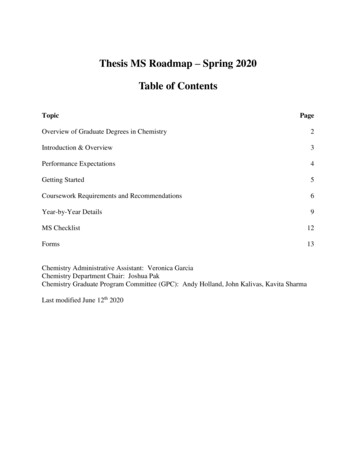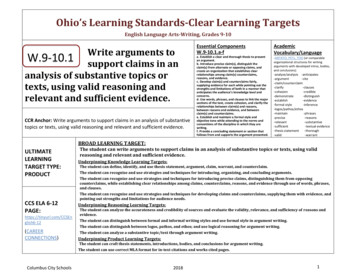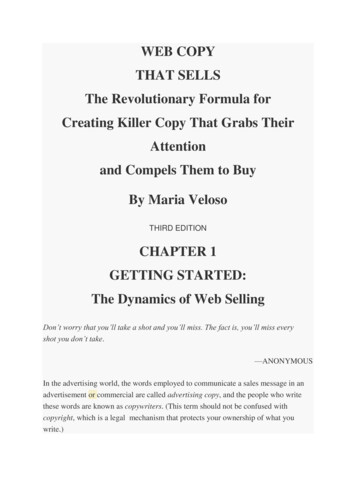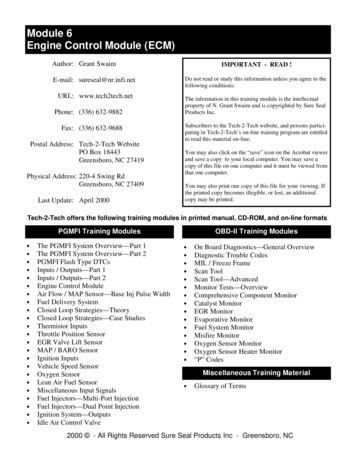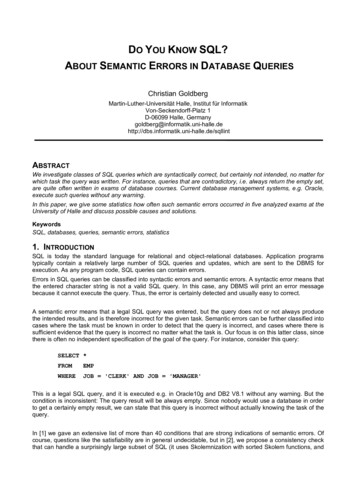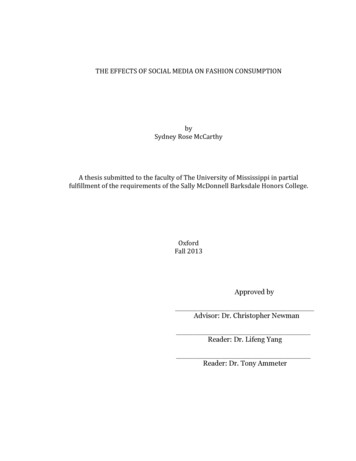
Transcription
fordFall2013Approved byAdvisor: Dr. Christopher NewmanReader: Dr. Lifeng YangReader: Dr. Tony Ammeter
2013Sydney Rose McCarthyALL RIGHTS RESERVEDii
ngsupport.iii
ABSTRACTSYDNEY ROSE MCCARTHY: The Effects of Social Media on FashionConsumption(Under the direction of Dr. Christopher sumption,specificallyamongthefemale,college- ites.WhileFacebookandiv
haguidelineformasteringsocialmediausage.v
TABLE OF CONTENTSINTRODUCTION . . . 1CHAPTER I: SOCIAL MEDIA . . . . 4CHAPTER II: THE FASHION INDUSTRY . . 13CHAPTER III: QUALITITATIVE DATA . . . 18CHAPTER IV: QUANTIATIVE DATA . . .24CHAPTER V: IMPLICATIONS . 29CHAPTER VI: LIMITATIONS . . . 37CONCLUSION . 38APPENDIX . . . .39LIST OF REFERENCES .45vi
INTRODUCTIONIn the past decade, social media has redefined the world we are living in. Whatbegan as a means to communicate, maintain contact, or reconnect with old friends, hasslowly but surely evolved into a crucial part of our daily lives; severely altering the waybusiness is done. One specific area of business that has been particularly affected by thesocial media revolution is the fashion industry. Through the institution of social media,what was once only available to elite insiders is now accessible by the masses. Forexample, because of a designer’s Facebook page, Twitter feed, or Instagram account,those previously unconnected to high fashion can now watch live footage fromMercedes-Benz Fashion Week taking place in New York City, an opportunity that wasonce only limited to industry insiders, celebrities, and socialites.Before the existence of these social media outlets, sales, store traffic, andfinancial records were conceivably the only way to gauge consumers’ opinions. Todaythough, “the cliché that ‘the customer is king’ has taken on a whole new definition.Customer feedback today not only reaches the companies much faster, but can alsospread out to a much broader audience through ‘friends’ of the customer commenting onsocial media” (Savitz). Companies are now forced to listen and pay attention to customeropinions because failure to do so could cause a demise of their reputation by means ofsocial media slander.vii
This being said, there is no way to communicate that is more cost effective ortime efficient than social media. In order to remain a market fixture, bricks and mortarretailers must adapt and begin utilizing social media as a cornerstone in their businessstructure.While the adaptation to changing technologies is vital to all types of retailers,Fashion retailers should take special notice. In some sense, fashion is a product of ourenvironment. That is to say, trends constantly come and go and fashion is largely everchanging. From the consumer’s perspective, it is easy to see how social media could be avehicle to expedite communication of these trends. However, from a retailer’sperspective it is vital to remain not only completely informed, but also very connected, inorder to better serve customers’ needs.Oxford, Mississippi is unique to the fashion industry in that there is a highlyconcentrated female population, ages 18-22, which possesses a high level of disposableincome to spend on fashion. The University of Mississippi is notorious for this element ofits’ student body and it becomes exceptionally obvious after spending only a shortamount of time in The Grove or The Square on any given weekend. One undergraduateposted, “The typical Ole Miss female student is attractive, wears good-looking clothes,and usually has her daddy's credit card in her back pocket” (Urban Dictionary). Whilemany may view this stereotype as negative, the reality is the demographic exists. Thisbeing said, it would be strategic for local, high-end, retailers to take advantage of theopportunities social media outlets present.Even more, it is no secret that the role of social media in a college town would bemagnified. Today’s college demographic is conceivably the first generation to grow up2
utilizing social media from an early age and to have the Web serve as an integral part oftheir social lives. More precisely, it seems as though females are more active on thesesocial media outlets and coincidentally are the ones most likely to follow fashion trendsreligiously.3
CHAPTER I: SOCIAL MEDIAIt is no secret that social media dominates many facets of life as we know it. Asstated prior, in the past decade particularly, social networking has grown exponentially.To say that the industry has skyrocketed would be an understatement—it has completelyrevolutionized the world we live in. While there are a number of different media sites,Facebook, Twitter, and most recently Instagram and Pinterest have soared and becomepart of the day-to-day life for many. One could say these four sites dominate the marketand embody the ideas and things one associates with “social media” in conversation.In less than ten years, Facebook evolved from a “fledging startup to a 114 billiongiant” (Reporter, IBTimes Staff). Because of its early introduction, Facebook dominatesthe social media world today and encapsulates all that the industry entails. It is a place tokeep in touch with friends, share content, and even obtain news and information.Although social media sites did exist prior to Facebook, they were quicklydethroned as Facebook picked up momentum. For example, in 2006, MySpace was thecenter of the social media universe. However by 2009 Facebook had more accounts openand was growing rapidly (Robertson). Perhaps people were so drawn to Facebook in its’early years because of the newness and excitement surrounding the innovation. However,unlike many of its opponents, Facebook does not seem to be going anywhere and whathas kept devotees loyal for so many years is something much more complex than a newlayout, status bar, or photo feature.4
According to recent research “two new studies have found that the social networksatisfies basic human desires, both body and soul.” (Mehta). The network may owesome of its success to the positive, feel-good state it invokes in its users. Researchfindings also revealed that two primary social needs might be responsible for peoplerepeatedly visiting the site. The first need is the central desire to belong. Humans arewired to connect with other humans, as well to feel accepted by them. Facebookencourages these connections in two steps. (Sheldon, Abad, & Hinsch, 2008). Feelingdetached initially motivates individuals to use the site (essentially as a copingmechanism), and in turn, the more frequently someone uses the site, the moreconnections they gain. “The second social motivation Facebook responds to is selfpresentation, in which users fashion ideal — rather than accurate — versions ofthemselves through their profiles” (Mehta). This is manifest in, for example, the numberof ‘friends’ in their network and photographs. Subsequently, Facebook personas that arepresented online may be a more socially appealing ‘self’ that is aspired to in reality, butone that is not yet realized (Zhao & Zhao, 2008)” (Mehta).Via this research, it is easy to grasp the reality of why Facebook has become sucha staple to daily life. People enjoy feeling in control of their own worlds and Facebook isprecisely the place to do so. In May 2012, Facebook’s Initial Public Offering wasexceedingly underwhelming. However, in the grand scheme of things, this so-called“flop” has not seemed to slow down the site’s success. Because of users’ almostreligious habit, the site is still flourishing and it seems only natural that more and morebusinesses would eventually hop on the bandwagon and utilize the site to theiradvantage.5
While Facebook currently governs the arena, Twitter is another outlet that quicklygarnered impetus. Jack Dorsey, then an undergraduate student at New York University,formed Twitter on the brink of the social media cusp in 2006 (Godarzi). The idea wassparked through Dorsey’s interest of a potential instant messenger for groups. It beganwhen Dorsey was working at DMS, one of the biggest courier services in the country.He was a software developer writing dispatch software but “became fascinated by thefact that all of the users of the software- taxi drivers, limo drivers, couriers- were reallyjust reporting what they were doing, baring down essential facts only, thus the idea forTwitter was envisioned.” (Carlson). Through a long series of events, Dorsey eventuallybecame connected with a tech-start up company and made his idea of a statusbroadcasting system a reality. Known then as “twttr”, it was a system where one couldsend a text to a single number and it be broadcasted to a multitude of friends. Dorseysaid, “we came across the word ‘twitter’, and it was just perfect. The definition was ashort burst of inconsequential information’, and ‘chirps from birds.’ And that’s exactlywhat the product was” (Carlson).A common complaint regarding Facebook is often that it is simply “too much.”Some people do not care to be bombarded with photos and long-winded status updatesand Twitter largely eliminated this facet. Since only 140 characters are allowed pertweet, account holders can scroll the site easily via computer, tablet, or smart-phone andconsume immense amounts of information in a relatively short time period. Anotherperk Twitter offers is the fact that one does not have to “tweet” or create a page in orderto have access--whereas it is impossible to peruse Facebook without setting up a page ofyour own prior.6
While many may view Twitter as merely a spin-off of Facebook, its’ differingqualities may be partially responsible for its’ growing success. “Pew Research Center’sfigures suggest it will be difficult for Twitter to reach Facebook's billion-memberplateau. However, in the last nine months of 2012, Twitter users increased by more than40%”. (Berman). Twitter’s major profits lie in advertisements in which companies arefundamentally paying to be talked or “tweeted” about. Berman elaborates and writes, “itremarkable because Twitter has been in the money-making game for only three years,primarily selling "sponsored tweets" to advertisers whose come-ons pop up in themessage streams of the service's 200 million-plus active users” and revenues are pushingthe billion-dollar mark. (Berman)As stated prior, overall, the beauty of businesses employing social media is thatthere is relatively zero overhead cost. Unlike paying for space in a newspaper,purchasing time on television for a commercial, or leasing a billboard, access to socialmedia is free. Berman said it best when he stated, “That magic is the value of free labor.The company doesn't have to pay a cent for the 400 million messages sent each day. Aswith Facebook, the users willingly, voraciously, do the work gratis” (Berman).While Facebook and Twitter now seem like almost basic commodities, Instagramis the latest craze to indulge in the spotlight. Recently acquired by Facebook,“Instagram is an online photo-sharing and social networking service that enables itsusers to take pictures, apply digital filters to them, and share them on a variety of socialnetworking services, such as media sites including Facebook or Twitter” (What isInstagram?). To some, it can be considered the Polaroid of our generation; images areeven specifically formatted for iPhone compatibility. Whereas Twitter took the status-7
update aspect of Facebook and capitalized on it, Instagram has effectively done the samewith the photo-sharing component and announced on February 26, 2013 that it reached100 million monthly users, “meaning 100 million people are using Instagram at leastonce a month and many are probably using it more often” (Tinari). In addition,approximately 40 million photos are posted each day, along with site traffic translatingto 8500 “likes” per second, and 1000 comments per second (Instagram Press).According to Douglas Rushkoff, a contributor to CNN, “Instagram has risen to the levelof a Twitter as far as the culture around it is concerned. It has spawned a new visuallanguage, a new etiquette of sharing and an outpouring of creativity in the form ofcontests, collaborative art exhibits and personal expression. Instagram got so popular sofast that Facebook took notice and purchased the company for a billion dollars -- (yes, 1 billion) -- to bolster its own smart phone presence shortly before its IPO.”(Rushkoff).Statistics like these are what prove Instagram is the new “it” thing and businessesare quickly taking notice. Instagram provides a platform for businesses to give customersa behind the scenes look and exclusive access to their company—thus making theconsumer feel more connected and hopefully more likely to continue supporting thebrand. In the retail world, many firms are utilizing Instagram as a type of e-catalog,however this may not be the best approach. “When it comes to Instagram, followers wantto see behind-the-scenes images from their favorite companies that they wouldn'tnormally be able to through traditional media. For example, Burberry, unlike its high-endcompetitors, uses its account to post cool images of London, where the company is based,along with backstage pictures from photo shoots. It posts the occasional merchandise8
image, but does not flood its account with boring pictures of clothing” (Austin). Thepremise of using Instagram as a means to promote business is to give consumer’ssomething they normally would not experience from walking into a store or even cruisinga website. The goal is to make patrons feel as if they are part of the company and are “inthe loop” with any major happenings before something goes mainstream.Pinterest, a social bookmarking site where users collect and share photos of theirfavorite interests, events, hobbies, and more. It is one of the latest and fastest growingsocial networks online; the third largest networking site behind only Facebook andTwitter and businesses are quickly gaining a presence on the site (Pinterest). Founded byBen Silberman in 2010, the site began as an exclusive, invitation only community,however with the implementation of an iPod and iPad app, has grown to over 12 millionusers- making it the fastest site in history to break through the 10 million unique visitormark (Hinseth). Primarily dominated by female users, Pinterest allows each accountholder to curate their own boards and categorize them. Typical categories include travel,fashion, cooking, interior design, quotes, and artwork.It is only recently though that businesses have begun taking notice of theopportunities Pinterest presents from a marketing standpoint. In a Forbes article writtenin June of 2012, Scott Gillum states, “Despite the hype and the record-breaking growthrates, Pinterest is not ready for business marketers; the demographics are wrong, thecategories are too consumer focused, and there are significant copyright andmeasurement issues to overcome” (Gillum). This fact was stated nearly 1 year agoexactly and Gillum stood correct in saying 2013 would be Pinterest’s year. In many ways,Pinterest’s platform has the potential to offer far more value than Facebook and Twitter9
because of its ability to aggregate and naturally curate content. Gillum claimed there werefive major areas to watch:1. “Traffic”- Pinterest’s ability to drive referral surpasses any other socialmedia outlet. This traffic generated from pinning and repining isextremely beneficial to small business owners, especially retailers.2. “Scannability”- Pinterest is tremendously visual and easy to access.Shockingly, many corporate websites are being redesigned to look morelike Pinterest and share the same inviting and accessible qualities.3. “Speed”- Once again Pinterest’s visual nature allows for nearly light speedprocessing. It only takes 1/20th of a second to process an image versus the200 to 300 words per minute that reading requires. It is often said a pictureis worth a thousand words and Pinterest delivers.4. “Natural Content Curation”- Users organization of boards and categoriesmay provide deeper insights into consumer behavior. “Marketers may findthat business audiences within Pinterest organize and consume content bycategories or by a pinboard defined as “applications,” i.e., how they intendto use the product and not how they will buy it. This insight could helpdefine the real purchase path and key influencers (pinners) along thatjourney.”5. “Affinity Data”- Information from Facebook on user “interests” is nothingcompared to the affinity data that could be mined from Pinterest. ScottBrave, CTO of Baynote software, wrote: “Individual pinning choices areinteresting, but there is even greater opportunity to analyze segments of10
people who express an affinity for a product or category in aggregate.” Ifavailable, this information could enable marketers to create newsegmentation clusters based on common interests, which could helpimprove messaging and targeting. ‘Clustering’ could identify brandadvocates, key influencers and connectors, local ‘hot spots’ and new ideasfor reaching them” (Gillum).Through the analysis of Facebook, Twitter, Instagram, and Pinterest, it is veryapparent why businesses are hopping on board. These social media outlets dictate theday-to-day life of many company’s prime demographic, therefore to maintain contactwith consumers, they must position themselves at an angle to do so; by creating anaccessible, yet professional presence on these sites.More specifically, social media holds a noteworthy place in the lives of collegestudents. Young adults, ages 18-24, are the first generation to grow up with social mediaplaying a constant role. Sure older generations are catching on, however many of theseyoung adults have been utilizing Facebook since elementary school. Social media hasbecome a normal part of their day to day lives, in the fact that the first thing many dowhen they wake up is check their Facebook account or see what’s happening via Twitter.In the past, to obtain news meant turning on a television or reading a newspaper.However in today’s society, Twitter can be considered a primary news source.Oxford, Mississippi is interesting in that it is a college town-- home to thousandsof adolescents who are constantly connected via their iPhones or smartphones. At thisage, it seems that many people are living their lives and partaking in experiences solely tobroadcast it later on their Facebook, Twitter, or Instagram. Facebook has even further11
facilitated this phenomenon by making one’s profile into a sort of social media “hub”;linking all three sites so when someone tweets, posts a photo to Instagram, or Pins anitem, it automatically syncs with their Facebook profile. It is easy to grasp this idea afterspending only a short time on campus at Ole Miss or even off-campus at a restaurant orstore. Just by looking around, one can observe that students are literally glued to theirphones; constantly updating their pages, letting their network know what they are doingstep-by-step. Furthermore, after posting a photo, writing a status, or sending a tweet, thepsychological component begins as the author waits to see how many “likes” orcomments he or she receives. It is this sense of validation obtained through social mediadiscussed earlier that creates loyal users and keeps people coming back for more.Oxford is also interesting in that it is a tremendously appearance-oriented town. Itis known for not only a beautiful campus, but also beautiful people and students arecertainly aware. There is definitely a notion among female students to dress the best andflaunt designer clothing, jewelry, and accessories. Whether it is a certain handbag, line ofjewelry, shoe, or general “look”, when something is “in” at Ole Miss, it is not uncommonfor the vast majority of girls to own it.12
CHAPTER II: THE FASHION INDUSTRYAccording to the Encyclopedia Britannica, “ the fashion industry is a multibilliondollar global enterprise devoted to the business of making and selling clothes. Someobservers distinguish between the fashion industry (which makes ‘high fashion’) and theapparel industry (which makes ordinary clothes or ‘mass fashion’), but by the 1970s theboundaries between them had blurred. Fashion is best defined simply as the style orstyles of clothing and accessories worn at any given time by groups of people.” (Steel andMajor). It is evident today that the fashion industry plays a large role in society. Peopleuse fashion as a mean’s of expression and a source of self-identity. There may seem to bea substantial gap between the expensive, exclusive high fashion of New York and Parisand the mass-produced casual wear sold in shopping centers of suburbia however, allspectrums of the fashion industry incorporate the same concepts of “design,manufacturing, distribution, marketing, retailing, advertising, and promotion of all typesof apparel (men’s, women’s, and children’s) from the most rarefied and expensive hautecouture (literally, ‘high sewing’) and designer fashions to ordinary everyday clothing—from couture ball gowns to Juicy Couture-brand sweatpants” (Steel and Major).To demonstrate the weight the fashion industry holds in today’s realm, in 2010,the world clothing and textile industry reached almost 2,560 trillion and the women’swear sector alone is expected to pass 621 billion by 2014 (Breyer). In solely one year,the United States spent 250 Billion on fashion consumption (Fashion Industry13
Statistics). These massive dollar amounts express how big of a role the fashion industryplays into the consumption patterns of people around the world.If thinking logically, it only makes sense to assume the fashion industry willalways exist. There are over 7 billion people in the world and clothing- whetherconsidered fashionable or not- will always be a necessity, therefore some demand willalways exist. Many might argue that fashion is a luxury and critics wonder why it’s evensignificant, being as the majority of the world cannot even afford authentic couture.However, in a recent interview on The Colbert Report, Anna Wintour, editor in chief ofVogue magazine, defended the industry. She said, “In the same way that most peoplewho admire a Picasso will never be able to buy one, the majority of people who pine foran iconic Chanel suit will never feel that wool against their skin. Nevertheless, much asone can still appreciate Picasso's pieces and his invaluable contributions to the art worldas co-founder of the cubist movement, one can still look at early Chanel designs and seehow themes of women's empowerment and activity were manifested in the designs”(LaGrave). What Wintour is arguing is that a deeper appreciation for fashionencompasses an understanding of its trends, influences, messages, and history- much likefine art- and perhaps this greater significance is what keeps buyers captivated.Also akin to fine arts, it cannot be denied that high fashion is certainly a luxury.Because most people cannot afford to indulge, the desire to experience the “look” of highfashion is further intensified. Thanks to stores such as H&M, Forever 21, and evenTarget, even the most price-conscious consumer can position themselves as awaretrendsetters. Therefore, the psychological aspects of the industry not only can justify theelite, high-end shoppers, but also the bargain hunters. Unlike in the past, today's14
designers function in a global marketplace, constantly expanded by television, film, andpopular culture—but even further accelerated by the Internet and social media. No longerlimited to the upper class, trendsetters come from various social factions, and most trendshave short trajectories. In a clinical analysis of New York Fashion week, psychologist Dr.Jennifer Baumgartner noted that the brain loves new things, especially trends becausethey are quick flashes of novelty. Much like repainting a room, or buying new furniture,the purchase of a new, trendy item allows for reinvention and the purchase of a wearabletrendy item allows for self-reinvention (Baumgartner). Also, as stated earlier, fashion isconstantly being influenced by its’ surrounding environment- be historical events,technological advancements, or changing social roles and sporting this fashion is a meansof expression. Personal stylist Jill Marinelli states, “All dress choices are internallymotivated and can be analyzed to reveal the inner self. Trends chasing is often motivatedfrom a desire to fit in, feel current, and masks insecurities. These ever-changing fashiondictates never allow for a concrete identification of your look, your preference, andultimately the message you want to put forth in the world” (Baumgartner). In essence, theway one chooses to dress is a reflection of their truest self.Much like fashion, social media is another outlet to express oneself. However,this means of expression occurs in cyberspace. There are many underlying threads thatlink the two together. For example, the psychological aspect to present oneself in acertain way exists in both outlets. People dress a particular way to present themselves tothe world in that manner, analogous to the way users may arrange his or her Facebookpage, Twitter account or Instagram. Additionally, the desire to fit in and be includedpresents itself via fashion and social media. Consumers of fashion want to be a part of the15
latest trend and receive accolades from peers, much like users of social media want their“friends” or “followers” to like and comment on their posts. Finally, the idea of appealingto the masses is also something the two outlets hold in common. Today, there are over 1billion users of social media and minority gaps are virtually non-existent. Surprisinglyenough, not using social media now typically equates to an heir of elitism, not theinability to access it, as in the past. “Many Facebook refusers actually revel in theirdifference from the mainstream, seeing it as a mark of distinction, superior taste, andidentification with an elite social stratum,” said New York University Professor LauraPortwood-Stacer. “Hipsters find it too mainstream and others find their privacypolicies troublesome. In other words, not using social media is likely a product of moreeducation, not a lack of access” (Ferenstein).Since the economic downturn of 2008, the fashion industry has had to repositionitself and shift gears away from appealing solely to the upper class. Many designers areteaming up with lower end retailers to give the price-conscious consumer an option tostill enjoy fashion on a budget. Major designers such as Isaac Mizrahi, Jean PaulGaultier, Sonia Rykiel, Zac Posen, Proenza Schouler, and Erin Fetherston have joinedforces with Target and Vera Wang has even created a separate label for Kohl’s. Providingthe masses with “right-priced” fashion has become the name of the game (Nalls). NewYork Fashion week is no longer limited to the press and buyers, but now more of aspectacle and source of promotion for designers. Apple launched a fashion app called“Fashion: Apps for the Clothes-Minded” and connected the world’s biggest global fastfashion retailers like Zara, Gap and H&M, with high-fashion houses like Chanel, Gucci,Fendi, Donna Karan, Diane von Furstenberg, and Dolce Gabana to name a few. These16
fashion week apps allow for shopping, sharing, fashion news, and access to videos. Inaddition, anyone with web access and a credit ca
many may view this stereotype as negative, the reality is the demographic exists. This being said, it would be strategic for local, high-end, retailers to take advantage of the opportunities social media outlets present. Even more, it is no secret that the r
